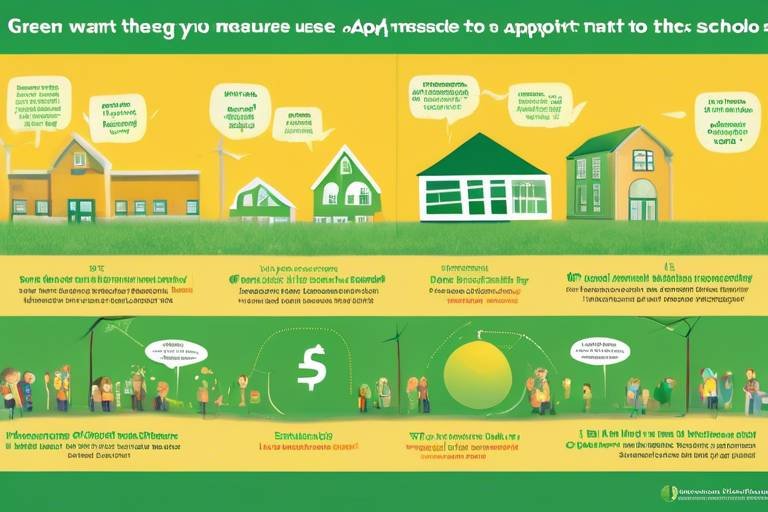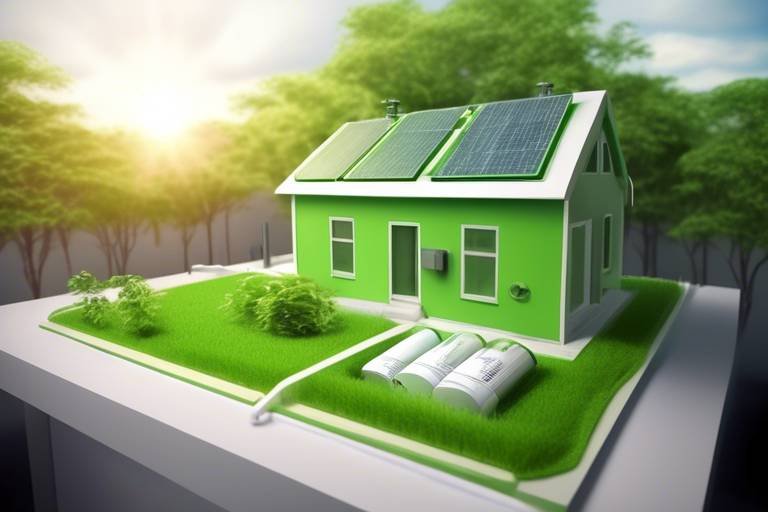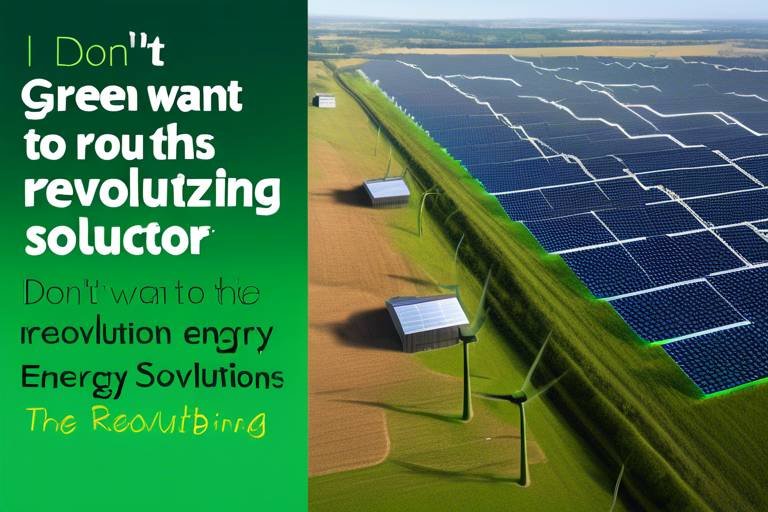Green Energy Measures that Schools Can Adopt
In today's world, the urgency for sustainable practices has never been more pronounced, especially within educational institutions. Schools are not just places of learning; they are also communities that can lead by example in the fight against climate change. By adopting green energy measures, schools can significantly reduce their carbon footprint while also instilling a sense of environmental responsibility among students and staff. Imagine a school where students learn not only from textbooks but also from their surroundings, where every lesson is intertwined with the principles of sustainability. This is not just a dream; it's an achievable reality that can inspire a new generation of eco-conscious leaders.
The journey towards sustainability begins with understanding the various measures schools can implement. From harnessing the power of the sun with solar energy to improving energy efficiency through modern technologies, the steps are both practical and impactful. Each initiative not only contributes to a greener planet but also offers educational opportunities that can transform students' perceptions of energy consumption and environmental stewardship.
Furthermore, schools can serve as hubs for community engagement, where local resources and knowledge can be shared to amplify the impact of these green initiatives. By fostering a culture of sustainability, schools can create an environment where students feel empowered to make a difference, both in their immediate surroundings and beyond. In this article, we will explore specific measures schools can adopt, making the case for why these initiatives are essential not just for the planet, but for the holistic development of students.
Integrating solar panels into school buildings is one of the most effective ways to reduce energy costs and reliance on fossil fuels. Imagine a school where the roof is adorned with solar panels, soaking up the sun's rays, and converting them into clean energy. This not only lowers utility bills but also provides students with hands-on learning opportunities about renewable energy technologies. Schools can even incorporate solar energy projects into their science curriculum, allowing students to see firsthand how solar energy works and its benefits.
Upgrading lighting, heating, and cooling systems to energy-efficient models can lead to significant reductions in energy consumption within schools. This not only creates a healthier environment for students and staff but also results in substantial savings on utility bills. For instance, switching to LED lighting can drastically reduce energy usage in classrooms and hallways. These bulbs have longer lifespans and lower maintenance costs compared to traditional incandescent bulbs, making them a smart investment.
LED lighting is not just about saving energy; it also enhances the learning environment. The bright, clear light emitted by LEDs can improve concentration and reduce eye strain for students. Schools that embrace this technology can see a transformation in their classrooms, where students are more engaged and focused.
Implementing smart lighting systems that adjust based on occupancy and natural light can enhance energy savings while improving the overall learning environment. These systems ensure that lights are only on when needed, further reducing energy waste and costs.
Utilizing natural light through design strategies can minimize the need for artificial lighting. Schools can incorporate large windows and skylights to allow sunlight to flood into classrooms, creating a more pleasant atmosphere for students while contributing to energy efficiency.
Enhancing insulation in school buildings is another crucial step towards sustainability. Proper insulation helps maintain comfortable temperatures, reducing the workload on heating and cooling systems. This not only leads to significant energy savings but also creates a more comfortable learning environment for students.
Schools can also adopt waste reduction measures, such as recycling programs and composting initiatives, to minimize landfill contributions. These programs not only reduce waste but also educate students on sustainable practices. Implementing comprehensive recycling programs encourages students to participate in waste reduction and fosters a culture of environmental stewardship within the school community.
Starting a composting program can help schools manage organic waste effectively. By turning food scraps into valuable compost, schools can teach students about the benefits of waste management and the importance of reducing food waste.
Incorporating environmental education into the curriculum can empower students to understand and engage with green energy practices. By integrating hands-on projects related to renewable energy, schools can enhance the learning experience and inspire students to pursue careers in sustainability and environmental science. Imagine students building solar ovens or conducting experiments with wind energy; these experiences can ignite a lifelong passion for the environment.
Encouraging community participation in green initiatives not only strengthens school-community ties but also amplifies the impact of sustainability efforts. When schools partner with local organizations, they can share resources and knowledge, creating a ripple effect that extends beyond the classroom.
- What are the benefits of solar energy in schools? Solar energy reduces energy costs, provides educational opportunities, and decreases reliance on fossil fuels.
- How can schools implement waste reduction strategies? Schools can start recycling programs and composting initiatives to minimize waste and educate students.
- Why is environmental education important? It empowers students to engage with sustainability practices and fosters a generation of environmentally conscious individuals.

Solar Energy Implementation
Integrating solar panels into school buildings is not just a trend; it’s a transformative step towards sustainability. Imagine a school where the sun powers the classrooms, where students learn not just about solar energy but also live it every day. By harnessing the sun’s energy, schools can significantly reduce their energy costs and reliance on fossil fuels. This implementation is like planting a seed of knowledge in students’ minds, nurturing their understanding of renewable energy technologies.
When schools install solar panels, they create a dual benefit: first, they cut down on electricity bills, which can be redirected towards educational resources, and second, they provide an invaluable hands-on learning opportunity for students. Picture students working on projects that involve monitoring energy production from solar panels or even conducting experiments to understand how sunlight is converted into electricity. This real-world application of science can ignite a passion for sustainability in young minds.
Furthermore, the installation of solar panels can serve as a practical demonstration of environmental responsibility. Schools can showcase their commitment to reducing their carbon footprint, inspiring students and the community to consider their own energy consumption habits. By displaying energy production data in common areas, schools can create a visual representation of their sustainability efforts, making the concept of renewable energy tangible and relatable.
In addition to the educational benefits, the financial savings from solar energy can be substantial. According to a recent study, schools can save up to 30% on energy costs after installing solar panels. This can free up funds for other essential programs, such as arts, sports, and science labs. Moreover, many states offer incentives and grants for schools that invest in solar energy, making it an even more attractive option. The initial investment may seem daunting, but the long-term benefits far outweigh the costs.
To put things into perspective, consider the following table that illustrates the potential savings and benefits of solar energy in schools:
| Benefit | Details |
|---|---|
| Cost Savings | Up to 30% reduction in energy bills |
| Educational Opportunities | Hands-on learning about renewable energy |
| Environmental Impact | Reduction in carbon footprint |
| Community Engagement | Inspires local community to adopt sustainable practices |
In conclusion, the implementation of solar energy in schools is a win-win situation. It not only significantly reduces energy costs and environmental impact but also enriches the educational experience for students. By embracing solar energy, schools can cultivate a culture of sustainability that extends beyond the classroom, influencing students to become responsible stewards of the environment.
- What are the initial costs of installing solar panels in schools?
The costs can vary widely depending on the size of the installation and local incentives, but many schools find that the long-term savings justify the initial investment. - How can students get involved with solar energy projects?
Students can participate in monitoring energy production, conducting experiments, and even engaging in community outreach to promote renewable energy. - Are there financial incentives for schools to go solar?
Yes, many states offer grants, tax credits, and other incentives to help schools offset the costs of solar energy installations.

Energy Efficiency Upgrades
Upgrading to energy-efficient systems in schools is not just a trend; it's a vital step towards creating a sustainable future. Imagine walking into a classroom that feels just right—not too hot, not too cold—thanks to smart heating and cooling systems that adjust automatically. These upgrades can lead to significant reductions in energy consumption, thereby lowering utility bills. But it’s not just about saving money; it's about creating a healthier environment for students and staff alike. Schools are where our future leaders are shaped, and they deserve the best possible conditions to thrive.
One of the most effective upgrades schools can implement is the transition to energy-efficient lighting. Traditional incandescent bulbs are like old friends that have overstayed their welcome. They consume a lot of energy and need frequent replacements. In contrast, LED lighting offers a longer lifespan and lower maintenance costs. Not only do LED lights use up to 75% less energy, but they also provide better lighting quality, which is essential for students' focus and productivity. Think of it as trading in a clunky old car for a sleek, fuel-efficient model. The benefits are clear.
When schools switch to LED lighting, they see a drastic reduction in energy usage, especially in high-traffic areas like classrooms and hallways. The initial investment might seem daunting, but the long-term savings are well worth it. For instance, a school that replaces just 100 incandescent bulbs with LEDs can save over $4,000 in energy costs over the lifespan of the bulbs. It's like finding money you didn't know you lost!
Now, let's take it a step further with smart lighting controls. These systems can adjust lighting based on occupancy and the amount of natural light available. Imagine walking into a classroom and the lights automatically dimming as the sun shines through the windows. This not only enhances energy savings but also creates a more comfortable learning environment. It’s like having a personal assistant for your lighting needs!
Another innovative approach is daylight harvesting. By strategically designing school buildings to maximize natural light, schools can significantly reduce their reliance on artificial lighting. This technique not only cuts down on energy consumption but also creates a pleasant atmosphere, making students feel more connected to the outdoors. Picture this: students learning in bright, sunlit rooms, surrounded by nature, which can boost their mood and concentration levels.
Let’s not forget about building insulation improvements. Proper insulation is like a warm blanket for your school, keeping it cozy in winter and cool in summer. Enhancing insulation can lead to substantial energy savings by reducing the workload on heating and cooling systems. This means less energy wasted and more money saved. Schools can invest those savings back into educational programs or extracurricular activities, which ultimately benefits the students.
In conclusion, energy efficiency upgrades are not just a smart financial decision; they are an investment in our students' future. By embracing these technologies and practices, schools can create a healthier, more sustainable environment that inspires students to become environmentally responsible citizens. It’s a win-win situation, and the time to act is now!
Q1: What are the benefits of energy efficiency upgrades in schools?
A1: Energy efficiency upgrades can significantly reduce energy costs, create a healthier learning environment, and lower the carbon footprint of the school. They also provide educational opportunities for students to learn about sustainability.
Q2: How long does it take to see savings from these upgrades?
A2: While the initial investment may take a few years to recoup, many schools report savings within the first year, especially with lighting upgrades and heating system improvements.
Q3: Are there grants available for schools to implement energy efficiency upgrades?
A3: Yes, many local and federal programs offer grants and incentives for schools to upgrade to energy-efficient systems. Researching these options can provide additional funding for your school's initiatives.

LED Lighting Solutions
Switching to LED lighting in schools is not just a trend; it's a revolution in how we think about energy consumption. Imagine walking into a classroom that feels bright and inviting, yet uses a fraction of the energy compared to traditional incandescent bulbs. This is the magic of LED lighting! Not only do LEDs provide superior illumination, but they also boast an impressive lifespan—up to 25 times longer than their incandescent counterparts. This means fewer replacements and less waste, which is a win-win for both the environment and school budgets.
One of the most compelling reasons to make the switch is the significant reduction in energy consumption. Schools often have long hours of operation, and the lighting can account for a substantial portion of their energy bills. By implementing LED lighting solutions, schools can achieve energy savings of up to 75%. This is particularly important in an era where every dollar counts, and schools are constantly looking for ways to cut costs without sacrificing quality.
In addition to the financial benefits, LED lighting enhances the learning environment. Studies have shown that well-lit classrooms can improve student concentration and productivity. Think about it: when students are comfortable and engaged, they are more likely to participate and absorb information effectively. This makes LED lighting not just an energy-efficient choice, but also a smart investment in student success.
Furthermore, LEDs come in various color temperatures, allowing schools to customize lighting for different activities. For instance, cooler, brighter lights can be used in science labs to enhance focus, while warmer tones can create a relaxed atmosphere in libraries. This adaptability makes LED lighting solutions incredibly versatile.
To illustrate the advantages of LED lighting, consider the following table that compares traditional incandescent bulbs with LED bulbs:
| Feature | Incandescent Bulbs | LED Bulbs |
|---|---|---|
| Energy Consumption | 60-100 watts | 8-15 watts |
| Lifespan | 1,000 hours | 15,000-25,000 hours |
| Heat Emission | High | Low |
| Cost per Bulb | $1.00 | $5.00 |
| Annual Energy Cost (based on 5 hours/day usage) | $21.00 | $3.00 |
As you can see, while the initial investment in LED bulbs may be higher, the long-term savings and benefits far outweigh the costs. Schools can redirect the funds saved on energy bills towards other essential programs and resources, ultimately enhancing the educational experience for students.
In conclusion, adopting LED lighting solutions is a step towards a more sustainable future for schools. Not only does it reduce energy consumption and costs, but it also creates a better learning environment for students. So, why not take the plunge and illuminate your school with the bright, efficient glow of LED lights?
- What are the main benefits of switching to LED lighting in schools?
The main benefits include significant energy savings, longer lifespan, reduced maintenance costs, and improved learning environments.
- How much can schools save by using LED lighting?
Schools can save up to 75% on their lighting energy costs by switching to LED lighting.
- Are LED lights more expensive than traditional bulbs?
Yes, the upfront cost of LED bulbs is higher, but the long-term savings on energy and replacement costs make them more economical.
- Can LED lighting improve student performance?
Yes, studies indicate that better lighting can enhance concentration and productivity among students.

Smart Lighting Controls
Imagine walking into a classroom, and the lights automatically adjust to the perfect brightness based on the amount of natural light streaming through the windows. are revolutionizing the way schools manage their energy consumption, creating a more responsive and efficient environment for both students and teachers. These advanced systems utilize sensors and automation to ensure that lighting is only used when necessary, significantly reducing energy waste. But how do they work, and what benefits do they bring to educational institutions?
At the heart of smart lighting controls are occupancy sensors and daylight sensors. Occupancy sensors detect when a room is occupied and turn the lights on or off accordingly. This means that if a classroom is empty, the lights will automatically shut off, saving energy without requiring any manual intervention. On the other hand, daylight sensors adjust the artificial lighting based on the amount of natural light available. When the sun is shining brightly, these sensors will dim the lights, ensuring that the room remains well-lit without wasting electricity.
The implementation of smart lighting controls can lead to substantial cost savings for schools. According to studies, schools can reduce their lighting energy consumption by up to 50% or more when utilizing these technologies. This not only translates to lower utility bills but also allows schools to allocate those savings towards educational resources and programs. Furthermore, with less energy consumption, schools contribute to a reduction in their overall carbon footprint, promoting a culture of sustainability.
But the benefits of smart lighting controls extend beyond just financial savings. A well-lit environment is crucial for student performance and well-being. Research has shown that proper lighting can enhance focus, reduce eye strain, and create a more inviting atmosphere for learning. By incorporating smart lighting solutions, schools can create an environment that is not only energy-efficient but also conducive to academic success.
In addition to these advantages, smart lighting controls can easily be integrated with other building management systems. For instance, they can work in tandem with heating and cooling systems to optimize energy use throughout the school. When the lights dim due to natural sunlight, the heating or cooling systems can adjust accordingly, further enhancing energy efficiency.
To illustrate the impact of smart lighting controls, consider the following table that compares traditional lighting systems with smart lighting systems in terms of energy savings, cost efficiency, and environmental impact:
| Feature | Traditional Lighting | Smart Lighting Controls |
|---|---|---|
| Energy Consumption | High | Low |
| Cost Efficiency | Higher utility bills | Significant savings |
| Environmental Impact | Higher carbon footprint | Lower carbon footprint |
In conclusion, adopting in schools is a win-win situation. Not only do they offer financial and environmental benefits, but they also create a more conducive learning environment for students. As educational institutions continue to seek ways to be more sustainable, smart lighting controls should undoubtedly be on their radar.
- What are smart lighting controls? Smart lighting controls are systems that use sensors and automation to manage lighting based on occupancy and natural light levels.
- How much energy can schools save with smart lighting? Schools can potentially reduce their lighting energy consumption by up to 50% or more.
- Do smart lighting controls improve student performance? Yes, proper lighting is crucial for focus and well-being, and smart controls can enhance the overall learning environment.

Daylight Harvesting Techniques
Daylight harvesting is a powerful technique that schools can implement to harness the natural light available in their environments. Imagine walking into a classroom where the warm glow of sunlight fills the room, reducing the need for artificial lighting. This not only creates a more inviting atmosphere but also significantly cuts down on energy consumption. By strategically designing spaces to maximize natural light, schools can promote a healthier learning environment while also contributing to sustainability efforts.
One effective way to implement daylight harvesting is through the use of large windows and skylights. These architectural features allow sunlight to penetrate deeper into the building, illuminating areas that would typically rely on artificial light. Additionally, the use of light-colored walls and reflective surfaces can amplify the effect of natural light, bouncing it around the room and enhancing visibility. This approach not only reduces energy usage but also improves the mood and productivity of students and staff alike.
Moreover, integrating automated shading systems can further optimize daylight harvesting. These systems adjust the amount of sunlight entering a room based on the time of day or the intensity of sunlight. For instance, during bright midday hours, shades can automatically lower to prevent glare, while in the early morning or late afternoon, they can retract to allow maximum light in. This dynamic approach ensures that classrooms remain well-lit without compromising comfort.
To illustrate the potential energy savings from daylight harvesting, consider the following table:
| Feature | Energy Savings (%) | Benefits |
|---|---|---|
| Large Windows | 30-50% | Improved mood, reduced reliance on artificial lighting |
| Skylights | 25-40% | Enhanced natural light, better ventilation |
| Automated Shading | 15-25% | Reduced glare, optimized light levels |
By adopting daylight harvesting techniques, schools not only reduce their energy bills but also foster an environment that encourages learning and creativity. Students can benefit from the natural rhythms of daylight, which can enhance their focus and engagement during lessons. Furthermore, this practice serves as a practical example of sustainability that educators can share with students, promoting awareness and responsibility towards energy consumption.
- What is daylight harvesting? Daylight harvesting is a method of using natural light to illuminate indoor spaces, reducing the need for artificial lighting.
- How can schools implement daylight harvesting? Schools can implement daylight harvesting by installing large windows, skylights, and automated shading systems to maximize natural light.
- What are the benefits of daylight harvesting? Benefits include reduced energy costs, improved mood and productivity, and a more sustainable learning environment.
- Can daylight harvesting impact student performance? Yes, studies have shown that natural light can enhance focus and engagement, positively affecting student performance.

Building Insulation Improvements
Improving building insulation in schools is not just a smart investment; it's a game changer. Imagine walking into a classroom that feels just right—neither too hot nor too cold. That's the magic of effective insulation! By enhancing the insulation of school buildings, educational institutions can achieve significant energy savings while creating a comfortable learning environment for students and staff. Not only does this lead to reduced heating and cooling costs, but it also minimizes the environmental impact by lowering the demand for energy.
One of the primary benefits of improved insulation is its ability to maintain consistent indoor temperatures. This means that during the winter months, classrooms stay warm and cozy, while in the summer, they remain cool and refreshing. This comfort translates into better concentration and productivity for students and teachers alike. Think of insulation as a protective blanket for your school—it keeps the warmth in during chilly days and the cool air in during sweltering summer afternoons.
When it comes to insulation materials, there are several options available, each with its unique advantages. For instance, fiberglass insulation is widely used due to its affordability and effectiveness. On the other hand, spray foam insulation offers superior air sealing capabilities, preventing drafts and ensuring that energy isn't wasted. The choice of material can depend on various factors, including budget, building design, and specific energy goals.
Furthermore, schools can also consider insulation upgrades during renovation projects or when building new facilities. This is an excellent opportunity to incorporate the latest insulation technologies that not only enhance energy efficiency but also promote sustainability. For example, using recycled materials for insulation can further reduce the school's carbon footprint while educating students about the importance of recycling and sustainability.
To illustrate the potential savings from improved insulation, consider the following table:
| Insulation Type | Estimated Energy Savings (%) | Cost per Square Foot ($) |
|---|---|---|
| Fiberglass Insulation | 20-30% | 0.50-1.00 |
| Spray Foam Insulation | 30-50% | 1.00-3.00 |
| Cellulose Insulation | 20-30% | 0.80-2.00 |
As schools embark on their journey toward better insulation, it's crucial to engage with professionals who specialize in energy efficiency. Conducting an energy audit can help identify areas where insulation improvements can be most beneficial. This assessment will provide a roadmap for schools to follow, ensuring that they maximize their investment and achieve the best results possible.
Ultimately, enhancing building insulation is a win-win situation. It not only contributes to significant cost savings on energy bills but also creates a healthier and more comfortable learning environment. By prioritizing insulation improvements, schools can lead by example, showcasing their commitment to sustainability and environmental responsibility. So, why not start this journey today? Your students and the planet will thank you!
- What are the benefits of improved building insulation? Improved insulation leads to energy savings, enhanced comfort, and reduced environmental impact.
- Which insulation material is the best choice for schools? The best choice depends on budget and specific needs, but fiberglass and spray foam are popular options.
- How can schools assess their insulation needs? Conducting an energy audit is an effective way to identify areas for improvement.
- Can insulation improvements really save money? Yes, better insulation can significantly lower energy bills by reducing heating and cooling costs.

Waste Reduction Strategies
In today's world, where environmental issues are at the forefront of global discussions, schools play a pivotal role in shaping the future of sustainability. Implementing effective not only helps minimize landfill contributions but also instills a sense of responsibility among students. Imagine walking through a school where every student actively participates in reducing waste, recycling materials, and composting organic scraps. This vision is not just a dream; it can be a reality with the right initiatives in place.
One of the most impactful strategies is the establishment of comprehensive recycling programs. These programs can transform the school environment by encouraging students to sort their waste into designated bins for paper, plastics, and metals. By doing so, students become not just passive learners but active participants in the school's sustainability efforts. Schools can create visually appealing and clearly labeled recycling stations throughout the campus, making it easy for students to engage. Additionally, hosting friendly competitions between classes to see who can recycle the most can add an element of fun and motivation.
Furthermore, schools can take it a step further by introducing composting initiatives. Composting is an excellent way to manage organic waste, such as food scraps from the cafeteria. By starting a composting program, schools can turn what would typically be waste into nutrient-rich compost that can be used in school gardens or donated to local community gardens. This not only reduces the amount of waste sent to landfills but also teaches students about the benefits of waste management and the importance of returning nutrients to the earth. Imagine students learning about the life cycle of food while actively participating in the composting process!
To ensure the success of these waste reduction strategies, schools must engage the entire school community. This includes not only students but also teachers, staff, and parents. Regular workshops and informational sessions can be organized to educate everyone about the importance of recycling and composting. Additionally, schools can collaborate with local environmental organizations to provide resources and support for these initiatives. The more involved the community is, the greater the impact of these sustainability efforts will be.
In conclusion, adopting waste reduction strategies in schools is not just beneficial for the environment; it is a powerful way to educate and empower the next generation. By implementing recycling programs and composting initiatives, schools can create a culture of sustainability that extends beyond the classroom. So, let's take a step towards a cleaner, greener future—one school at a time!
- Q: How can schools start a recycling program?
A: Schools can start by assessing their current waste management practices, setting clear goals, and providing accessible recycling bins throughout the campus. Involving students in the planning process can also foster a sense of ownership. - Q: What materials can be composted in schools?
A: Schools can compost fruit and vegetable scraps, coffee grounds, eggshells, and yard waste. It's essential to avoid composting meat, dairy, and oily foods to prevent odors and pests. - Q: How can students get involved in these initiatives?
A: Students can participate by joining environmental clubs, volunteering for waste audits, and spreading awareness about recycling and composting efforts within their school.

Recycling Programs
Implementing comprehensive in schools is a powerful way to engage students and staff alike in the vital practice of waste reduction. Imagine a school where every student not only learns about the importance of recycling but actively participates in it. This hands-on involvement fosters a sense of responsibility and environmental stewardship that can last a lifetime. By establishing clear guidelines and accessible recycling stations throughout the campus, schools can make it easy for everyone to contribute.
To kick off a successful recycling program, schools can start by conducting a waste audit. This process involves analyzing the types and quantities of waste generated on campus. Understanding what materials are most commonly discarded allows schools to tailor their recycling efforts effectively. For instance, if a significant amount of paper waste is identified, schools can implement specific paper recycling initiatives alongside educational campaigns about reducing paper usage.
Furthermore, engaging students in the creation of recycling slogans or posters can enhance their connection to the program. Not only does this encourage creativity, but it also promotes awareness among the student body. When students see their peers actively involved in promoting recycling, it can create a ripple effect, encouraging others to participate. Here’s a quick look at some key elements that can make a recycling program successful:
| Key Elements | Description |
|---|---|
| Education | Provide information on what can and cannot be recycled, along with the benefits of recycling. |
| Accessibility | Place recycling bins in high-traffic areas to encourage participation. |
| Incentives | Consider implementing reward systems for classes or grades that recycle the most. |
| Community Involvement | Invite local recycling companies to speak at school events or provide resources. |
In addition to traditional recycling, schools can also explore innovative recycling initiatives, such as upcycling projects. These projects encourage students to creatively repurpose materials that would otherwise be thrown away. For example, students can transform plastic bottles into planters or old t-shirts into reusable shopping bags. Such projects not only reduce waste but also spark creativity and resourcefulness among students.
Ultimately, the goal of a recycling program in schools is to create a culture of sustainability. By making recycling a fun and engaging part of school life, students learn that their actions have a direct impact on the environment. This awareness can lead to lifelong habits that extend beyond the classroom, contributing to a more sustainable future.
- What materials can typically be recycled in schools? Most schools can recycle paper, cardboard, plastics (check local guidelines), and metals. It's essential to provide clear instructions to students about what can and cannot be recycled.
- How can we encourage participation in the recycling program? Creating a sense of competition among classes, providing incentives, and incorporating educational activities can significantly boost participation.
- What should we do with items that cannot be recycled? Items that cannot be recycled should be disposed of properly. Schools can also explore waste reduction strategies to minimize these items.

Composting Initiatives
Composting initiatives in schools are not just about managing waste; they are a gateway to teaching students about the **importance of sustainability** and the environmental impact of our daily choices. By starting a composting program, schools can turn organic waste—like food scraps and yard waste—into nutrient-rich soil. This not only reduces the amount of waste that ends up in landfills but also provides an excellent opportunity for hands-on learning. Imagine students excitedly collecting their lunch leftovers to contribute to the compost bin, transforming waste into a valuable resource!
To implement a successful composting initiative, schools can follow a few essential steps:
- Education and Awareness: Begin by educating students and staff about what composting is and why it matters. Use engaging presentations, workshops, and even field trips to local composting facilities to pique interest.
- Set Up Composting Stations: Designate specific areas in the school for composting. These stations should be easily accessible and clearly marked, making it simple for students to know where to deposit their organic waste.
- Involve the Community: Encourage parents and local businesses to participate. They can donate materials, support funding, or even volunteer to help with the program.
One of the most exciting aspects of composting initiatives is the chance to create a **composting curriculum**. Schools can integrate composting into science classes, where students can learn about the decomposition process, soil health, and the role of microorganisms. This hands-on approach not only solidifies their understanding but also inspires a sense of responsibility toward the environment.
Moreover, schools can showcase their composting success by using the finished compost in school gardens or landscaping projects. This not only completes the cycle of waste-to-resource but also beautifies the school grounds, providing a visual representation of the benefits of composting. It’s a fantastic way to show students that their efforts have a tangible impact!
As schools embrace composting initiatives, they are not just reducing waste; they are fostering a culture of **environmental stewardship**. Students learn that every small action counts, and they carry these lessons into their homes and communities. This ripple effect can lead to more sustainable practices beyond the school walls, contributing to a greener planet for all.
Q: What materials can I compost?
A: You can compost a variety of organic materials, including fruit and vegetable scraps, coffee grounds, eggshells, grass clippings, and leaves. Avoid composting meat, dairy, and oily foods, as they can attract pests.
Q: How long does it take for compost to break down?
A: The composting process can take anywhere from a few weeks to several months, depending on factors like the materials used, moisture levels, and temperature. Regularly turning the compost can speed up the process.
Q: Can composting be done indoors?
A: Yes! Indoor composting can be done using a compost bin or worm composting (vermicomposting). This is especially useful for schools with limited outdoor space.

Environmental Education Integration
In today's world, where climate change and environmental degradation are pressing issues, integrating environmental education into school curricula is more crucial than ever. It's not just about teaching students the facts; it's about fostering a deep understanding and appreciation for our planet. By weaving sustainability into the educational fabric, schools can empower students to become proactive stewards of the environment. Imagine a classroom where discussions about the impact of plastic waste or the benefits of solar energy are as common as math problems or history lessons. This is the kind of transformative education that can inspire a new generation of environmentally conscious individuals.
One of the most effective ways to achieve this integration is through hands-on projects. These projects can range from simple activities like planting trees or starting a school garden to more complex initiatives such as building solar ovens or creating wind turbines. Engaging students in these practical experiences not only enhances their understanding of renewable energy technologies but also ignites their passion for sustainability. When students see the tangible results of their efforts, it reinforces the idea that they can make a difference. For instance, a school that implements a rainwater harvesting system provides students with a direct connection to the water cycle and conservation practices.
Moreover, community involvement plays a vital role in enhancing environmental education. Schools can collaborate with local organizations, environmental groups, and even businesses to create a network of support for green initiatives. This partnership not only enriches the learning experience but also strengthens the bond between schools and their communities. When students participate in community clean-up days or local environmental workshops, they learn valuable lessons about teamwork, responsibility, and the impact of collective action. These experiences can be life-changing, motivating students to pursue careers in environmental science, conservation, or sustainable development.
To effectively integrate environmental education, schools can consider the following strategies:
- Develop interdisciplinary lessons that connect environmental topics with subjects like science, math, and social studies.
- Encourage student-led initiatives that promote sustainability within the school, such as eco-clubs or green committees.
- Utilize technology to enhance learning, such as using apps that track energy consumption or platforms that facilitate virtual environmental projects.
Ultimately, the goal is to create a culture of sustainability within schools that extends beyond the classroom. By embedding environmental education into every aspect of the school experience, we not only prepare students to face the challenges of the future but also inspire them to take action today. As they learn about the importance of reducing their carbon footprint and conserving resources, they become ambassadors for change, spreading awareness and advocating for a greener world.
Q1: Why is environmental education important for students?
A1: Environmental education is essential because it helps students understand the impact of their actions on the planet and encourages them to adopt sustainable practices. It fosters critical thinking and prepares them to tackle environmental challenges.
Q2: How can schools implement environmental education effectively?
A2: Schools can implement environmental education by integrating it into the curriculum, using hands-on projects, collaborating with community organizations, and encouraging student-led initiatives focused on sustainability.
Q3: What are some examples of hands-on projects for students?
A3: Examples include starting a school garden, organizing recycling drives, conducting energy audits, and participating in community clean-up events. These projects provide practical experience and reinforce classroom learning.
Q4: How can parents support environmental education in schools?
A4: Parents can support environmental education by volunteering for school projects, advocating for sustainability initiatives, and encouraging their children to participate in eco-friendly activities at home.

Hands-on Projects
When it comes to engaging students in the world of green energy, are a game changer. Imagine a classroom buzzing with excitement as students roll up their sleeves to build solar ovens or create miniature wind turbines. These projects do more than just teach; they ignite a passion for sustainability that can last a lifetime. By actively participating in the creation of renewable energy solutions, students not only learn about the science behind these technologies but also develop critical thinking and problem-solving skills that are essential in today’s world.
One fantastic way to implement hands-on projects is through collaborative learning. For instance, schools can organize workshops where students work in teams to design and construct their own solar panels. This not only fosters teamwork but also allows students to share ideas and learn from each other's perspectives. The thrill of seeing their hard work come to life when their solar panel generates electricity is an experience they won’t soon forget.
Additionally, schools can partner with local environmental organizations to enhance these projects. For example, students can participate in community gardens that utilize sustainable practices. This not only teaches them about food production and the importance of local ecosystems but also connects them with their community. They can learn about composting, the benefits of organic gardening, and the impact of local food systems on the environment.
Here’s a brief overview of some exciting hands-on projects schools can implement:
| Project Name | Description | Learning Outcomes |
|---|---|---|
| Solar Oven Building | Students create solar ovens using simple materials to cook food. | Understanding solar energy, heat retention, and cooking techniques. |
| Wind Turbine Models | Students design and build small wind turbines to generate electricity. | Learning about wind energy, engineering principles, and renewable resources. |
| Community Garden | Students cultivate a garden using sustainable practices. | Understanding ecosystems, biodiversity, and the importance of local food. |
Moreover, these projects can be tied into the broader curriculum. For instance, while working on a solar oven, students can explore topics in physics, such as energy transfer and thermodynamics. This interdisciplinary approach not only makes learning more engaging but also helps students see the connections between different subjects and real-world applications.
In conclusion, hands-on projects are not just an educational tool; they are a pathway to cultivating a generation of environmentally conscious leaders. By providing students with tangible experiences in renewable energy, schools can inspire them to think critically about their impact on the planet and take action towards a sustainable future.
- What are hands-on projects? Hands-on projects are interactive activities that allow students to engage directly with the subject matter, often involving building or creating something tangible related to their learning.
- How do hands-on projects benefit students? They enhance engagement, foster teamwork, and improve critical thinking skills while providing practical applications of theoretical knowledge.
- Can hands-on projects be integrated into the existing curriculum? Absolutely! Many hands-on projects can complement subjects like science, math, and social studies, making learning more relevant and exciting.

Community Involvement
Community involvement is a crucial element in fostering a culture of sustainability within schools. When schools actively engage with their local communities, they not only amplify their green initiatives but also create a sense of shared responsibility and collective action towards environmental stewardship. Imagine a school where students, parents, and local organizations come together to plant trees, clean up parks, or even set up community gardens. This collaboration not only enhances the school’s environmental footprint but also strengthens the ties within the community.
One of the most effective ways to encourage community involvement is through partnerships with local businesses and organizations. These partnerships can lead to numerous benefits, including:
- Resource Sharing: Local businesses can provide materials, funding, or expertise for sustainability projects.
- Volunteer Opportunities: Community members can volunteer their time to assist with school initiatives, such as recycling drives or energy audits.
- Educational Workshops: Local experts can conduct workshops on renewable energy, waste management, and other green practices, enriching the learning experience for students.
Moreover, involving the community in sustainability efforts creates a ripple effect. When parents and local residents see their children actively participating in environmental projects, they are more likely to adopt similar practices at home. This can lead to a broader cultural shift towards sustainability within the community. Schools can host events like “Green Fairs”, where they showcase student projects, invite local eco-friendly businesses, and provide workshops on sustainability practices. Such events not only educate but also inspire community members to take action.
Another exciting aspect of community involvement is the potential for intergenerational learning. Older generations often possess a wealth of knowledge and experience in sustainable practices. By inviting senior citizens to share their wisdom through storytelling or hands-on demonstrations, schools can create a rich learning environment that benefits all ages. This not only reinforces the importance of sustainability but also fosters respect and understanding between generations.
In conclusion, community involvement is not just an add-on; it’s an essential component of a successful green initiative in schools. By cultivating partnerships, hosting events, and promoting intergenerational learning, schools can create a vibrant ecosystem of sustainability that benefits both students and the wider community. Together, they can pave the way toward a more sustainable future, proving that when we work together, we can make a significant impact.
- How can schools start involving the community in their sustainability efforts?
Schools can begin by reaching out to local businesses and organizations to discuss potential partnerships, organizing community events, and encouraging volunteer opportunities for parents and residents. - What types of projects can schools collaborate on with the community?
Possible projects include community gardens, recycling drives, tree planting events, and educational workshops on sustainability topics. - Why is community involvement important for sustainability?
Community involvement fosters a sense of shared responsibility, enhances educational experiences, and creates a broader cultural shift towards sustainable practices.
Frequently Asked Questions
- What are some benefits of implementing solar energy in schools?
Integrating solar energy can significantly lower electricity bills, reduce reliance on fossil fuels, and provide students with real-world learning experiences about renewable energy. It’s like turning your school roof into a mini power plant!
- How can energy efficiency upgrades improve the school environment?
Upgrading to energy-efficient systems not only cuts down on energy consumption but also creates a healthier environment. Imagine a classroom that’s not only comfortable but also costs less to operate—it's a win-win!
- What are LED lighting solutions, and why are they important?
LED lighting uses significantly less energy than traditional bulbs and lasts much longer. This means fewer replacements and lower maintenance costs. Think of it as giving your school a bright future without the hefty energy bill!
- Can you explain smart lighting controls?
Smart lighting systems adjust based on occupancy and natural light, ensuring that lights are only on when needed. It’s like having a personal assistant for your lights—always optimizing energy use!
- What is daylight harvesting?
Daylight harvesting involves using natural light to reduce the need for artificial lighting. It not only saves energy but also creates a more pleasant learning environment. Imagine classrooms filled with sunshine instead of just fluorescent lights!
- How can schools effectively implement recycling programs?
By setting up clear guidelines and bins for different materials, schools can encourage students to recycle. It’s about making recycling as easy as tossing a paper in the right bin—everyone can contribute!
- What are the benefits of composting initiatives in schools?
Composting helps manage organic waste and turns food scraps into valuable compost. It’s a great way to teach students about sustainability while reducing landfill contributions. Think of it as turning trash into treasure!
- How can environmental education be integrated into the curriculum?
Incorporating environmental topics into lessons can empower students to understand green practices. It’s like planting seeds of knowledge that will grow into a generation of eco-conscious individuals!
- What role does community involvement play in green initiatives?
Community participation can enhance sustainability efforts by sharing resources and knowledge. It’s all about building a network of support that amplifies the impact of green practices—together, we can make a bigger difference!



















